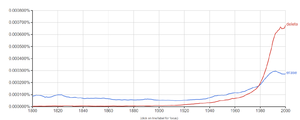MatthewCookNgram
Ngram Change in Language
Relationship between "Erase" and "Delete" in terms of analog vs digital erasure of information.
As seen in the attached graph, over time the english language has evolved its general concept of what it means to erase information. There is a clear turning point in the late 1970's when the computer age truly began to take hold. Previously, humans did not use the term "delete" as it refers to digital erasure from a hard drive or hard disk. Because of analog recording of data with pen, pencil and paper, it was much more common to erase something but with the change in how humans choose to record information, there is also the change in how humans get rid of said information. As seen in the graph, even at its most popular, erase never quite achieved the same level of prestige as delete did. This is probably due to the fact that deleting digital information is extremely easy with only a few keystrokes, while erasing something from paper is a seldom completed task with many simply writing on a new piece of paper, or crossing out previous mistakes.
This of course raises the question, has society grown more accustomed to mistakes? With the ease of fixing them, do we take less care when completing tasks, knowing we can simply go back and change them? While it may of course seem inconsequential, it is a subtle change in language that reveals how much more often we make mistakes. More than just the change from analog to digital writing, we have moved from taking care to not waste paper or ink, into a society where mistakes are minor inconveniences, easily fixed which could have a serious impact on the way people approach tasks in an every increasingly digital world.
